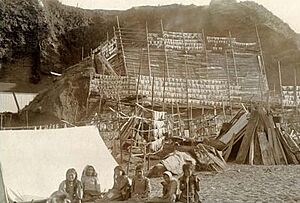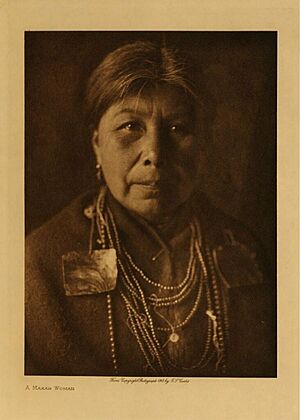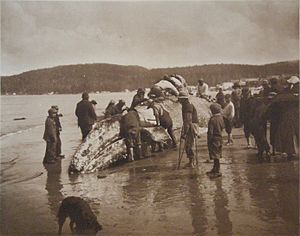Makah facts for kids
| qʷidiččaʔa·tx̌ | |
|---|---|
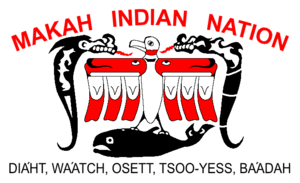
Flag of the Makah Indian Tribe
|
|
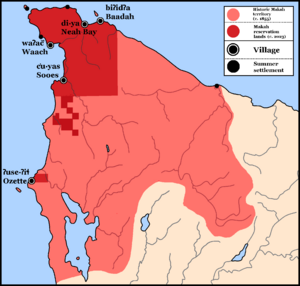
Makah territory (light red, c. 1855) overlayed with current reservation lands (dark red)
|
|
| Total population | |
| 1,213 | |
| Regions with significant populations | |
| United States (Washington) | |
| Languages | |
| English, Makah (survives as a second language) | |
| Religion | |
| Christianity, incl. Syncretism | |
| Related ethnic groups | |
| Nuu-chah-nulth, Ditidaht |
The Makah (/məˈkɑː/) are an Indigenous people who live in Washington, in the northwestern United States. They are part of the Makah Indian Tribe, which is officially recognized by the U.S. government.
They are closely related to the Nuu-chah-nulth and Ditidaht peoples. These groups live across the Strait of Juan de Fuca in British Columbia, Canada.
Contents
What's in a Name?
The Makah people call themselves qʷidiččaʔa·tx̌. This name means "the people who live by the rocks and seagulls." It can also mean "the people who live on the cape by the seagulls" or "people of the point."
The English name "Makah" comes from the S'Klallam language. In S'Klallam, màq̓áʔa means "generous with food."
Makah History
Life Before European Contact
Archaeological studies show that Makah people have lived in the area now called Neah Bay for over 3,800 years. Traditionally, the Makah lived in villages with large longhouses. These homes were made from western red cedar wood. Their cedar-plank walls could be moved to let in air or light.
The cedar tree was very important to the Makah. They used its bark to make waterproof clothing and hats. Cedar roots were used for weaving baskets. Whole cedar trees were carved into canoes. These canoes were used to hunt seals, gray whales, and humpback whales.
The Makah got most of their food from the ocean. Their diet included whale, seal, fish, and many types of shellfish. They also hunted deer, elk, and bear in the nearby forests. Women gathered nuts, berries, and edible plants and roots for food.
Japanese Shipwreck Survivors
In 1834, a Japanese ship lost its mast and rudder. It crashed near Cape Flattery. The Makah helped three survivors from the broken ship. The survivors stayed with the Makah for several months. Later, they were taken to Fort Vancouver. From there, the United States helped them travel by ship to London and then China. However, they never made it back to Japan.
The Treaty of Neah Bay
On January 31, 1855, Makah representatives signed the Treaty of Neah Bay with the U.S. federal government. Through this treaty, the Makah gave up much of their traditional land.
The treaty required the Makah to live on the Makah Indian Reservation. This reservation is located at 48°19′20″N 124°37′57″W / 48.32222°N 124.63250°W in Clallam County. The treaty also protected the Makah people's right to hunt whales and seals in the area. The Makah language was not used during the treaty talks. The government used the S'Klallam-language name for the tribe, not the Makah's own name.
Ozette Village Discovery
In the early 1600s, a mudslide covered part of a Makah village near Lake Ozette. Makah oral history tells of a "great slide" that buried part of Ozette long ago. The mudslide preserved several houses and their contents. They stayed buried until the 1970s.
In the 1970s, the Makah and archaeologists from Washington State University began to dig up the site. They found over 55,000 artifacts. These items show many parts of Makah life, from hunting whales and seals to fishing for salmon and halibut. Toys, games, and bows and arrows were also found.
The excavation of the Ozette site began in 1970 after a storm exposed some well-preserved wooden items. University students worked with the Makah. They used pressurized water to remove mud from six buried longhouses. The digging continued for 11 years.
Many of the artifacts are now on display at the Makah Cultural and Research Center. This museum opened in 1979. It shows copies of cedar longhouses, as well as whaling, fishing, and sealing canoes.
Makah Culture
Much of what we know about the traditional Makah way of life comes from their oral stories. The many archaeological finds at the Ozette village site have also taught us a lot about traditional Makah life.
Historically, Makah society had a class system. People in lower classes could improve their social standing by marrying into higher classes. The community was mostly based on family ties.
The traditional Makah family included parents and children living together. Family members were ranked in society based on their relationship to the tribe's chief. Men and women had equal roles. Both participated in hunting whales and other animals. While men were often fishermen and hunters, women focused on gathering resources for the family.
Whaling Traditions
Makah oral history says that their tradition of aboriginal whaling has been stopped and restarted many times. Most recently, the practice stopped in the 1920s. This was because commercial whaling had greatly reduced the number of humpback and gray whales. All hunting was then called off.
After the gray whale was removed from the Endangered Species List, the Makah said they wanted to restart their whaling rights. With help from the United States government and the International Whaling Commission, the Makah successfully hunted a gray whale on May 17, 1999.
According to federal law, the Makah can hunt and kill one baleen whale, usually a gray whale, each year. Old records and oral history show that many humpback whales were also hunted in the past. The Makah had not caught a whale for over 70 years before 1999.
The Makah whaling technique is difficult and requires a lot of effort. The men hunt from cedar canoes. Each canoe holds six to nine people. More recently, they also use small fishing boats. They go into the Pacific Ocean near their reservation.
Hunters use traditional methods to choose the best whale to hunt. By counting the whale's breaths, they know when it is about to dive. This helps them decide the best time to strike. The hunter approaches the whale's left side. They strike when the whale is 3–4 feet deep to avoid its powerful tail.
The harpoon is 16–18 feet long. It is made of two pieces of yew wood joined together. In the past, hunters used a mussel shell tip with barbs made from elk horns. Since the late 1900s, hunters have used a steel "yankee style" head. But they still use the yew wood shaft because it is flexible, water-resistant, and strong. Recently, hunters have also started using a big-game rifle after the harpoon strike. This helps to ensure a quicker kill.
Traditional ceremonies and songs are performed to welcome the whale's spirit. After this, the whale is divided in a very specific, traditional way. The meat and oil are given to community members. A large amount is eaten during a potlatch, which is a special feast.
The Makah say their right to whale hunting is guaranteed in the 1855 Treaty of Neah Bay. This treaty states: "The right of taking fish and of whaling or sealing at usual and accustomed grounds and stations is further secured to said Indians in common with all citizens of the United States."
Plants and Medicine
Makah women chew the roots and leaves of Viola adunca (a type of violet) when they are giving birth.
Modern Makah Life
In 1936, the Makah Tribe signed the Makah Constitution. This accepted the Indian Reorganization Act of 1934. It also created an elected tribal government. The constitution set up a five-member Tribal Council. Each year, the council chooses a Tribal Chairperson. The Council creates and passes laws for the Makah Reservation.
The Makah Tribe holds its main yearly public event called Makah Days in late August. It includes a big parade and a street fair. There are also canoe races, traditional games, singing, dancing, feasting, and fireworks.
Many Makah tribal members earn most of their money from fishing. They fish for salmon, halibut, Pacific whiting, and other ocean fish. This makes them especially affected by global warming. Ocean acidification harms the shells of molluscs (which are a main food source for fish). Warming waters also affect the salmon run.
To respond to these changes, the Makah tribe is using their traditional knowledge. They are creating plans for climate resilience that focus on the tribe's needs. The Makah tribe works with the Hoh, Quileute, and Quinault Indian Nation. They also work with scientists. Together, they do climate research and monitor the Olympic Coast National Marine Sanctuary.
Makah Language
The Makah language is the Indigenous language spoken by the Makah people. The name for the language is qʷi·qʷi·diččaq.
Makah belongs to the Southern Nootkan branch of the Wakashan family of languages. It is the only Wakashan language in the United States. Other tribes who speak Wakashan languages live in British Columbia, Canada. They are just across the Strait of Juan de Fuca on the west coast of Vancouver Island, and further north along that province's Central Coast.
Makah stopped being a first language in 2002. That was when its last fluent native speaker passed away. However, it is still used as a second language. The Makah Tribe is working to bring the language back. They have started preschool classes to teach it to their children.
Makah Reservation
The Makah Tribe owns the Makah Indian Reservation. It is located on the northwest tip of the Olympic Peninsula. It also includes Tatoosh Island. Makah people live in and around the town of Neah Bay, Washington, which is a small fishing village.
Tribal records from 1999 show that the Makah Tribe has 1,214 enrolled members. About 1,079 of them live on the reservation. The unemployment rate on the reservation is about 51%.
|
See also
 In Spanish: Makah para niños
In Spanish: Makah para niños


